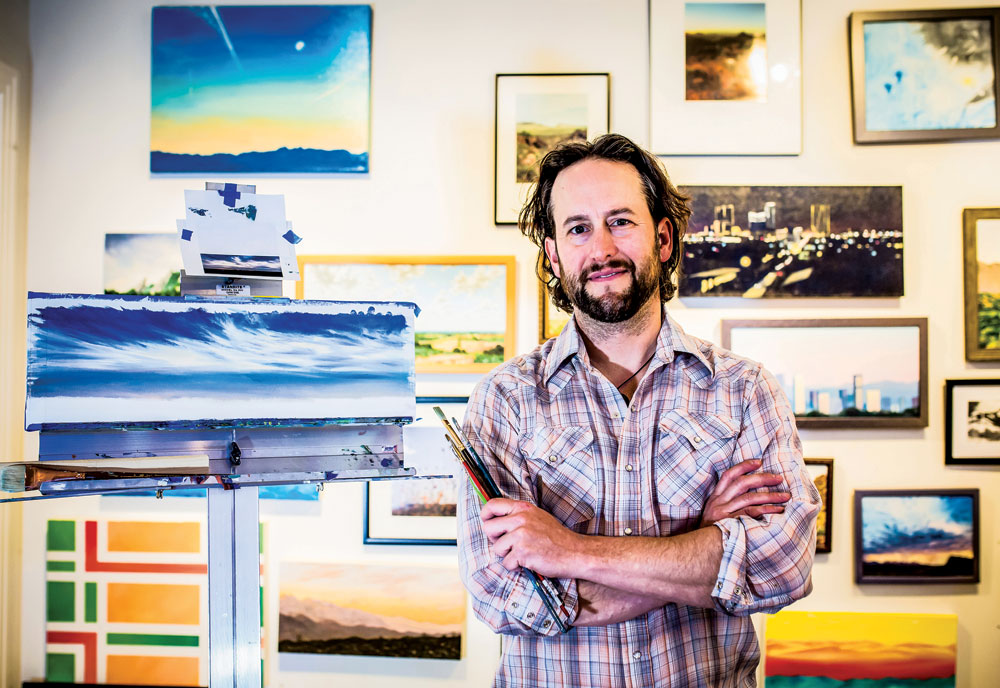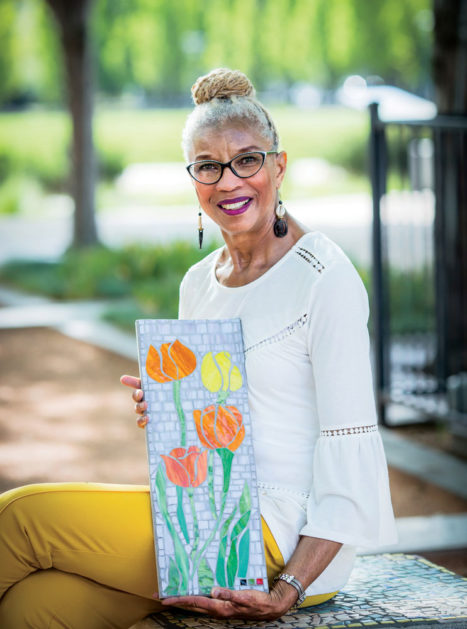
“We look at art and we get when it’s beautiful,” says painter Lance Ray. “But I like to look at ‘unpalatable’ objects in a different way.” Photo by KDaly Photography
 The eighth annual Central Park Artists Open Studios (formerly Stapleton Artists Open Studios) will spotlight neighborhood artists, this year in virtual form: an online flipbook featuring all 21 artists and links to their websites. The artists present a range of disciplines, including painting, photography, sculpture, jewelry, glass, fiber art and mosaic.
The eighth annual Central Park Artists Open Studios (formerly Stapleton Artists Open Studios) will spotlight neighborhood artists, this year in virtual form: an online flipbook featuring all 21 artists and links to their websites. The artists present a range of disciplines, including painting, photography, sculpture, jewelry, glass, fiber art and mosaic.
Every September since 2013, artists have opened their studios to meet visitors, show their work and demonstrate how it is made. All art is for sale. “The artists love to see people walk up to their work and smile, and ask, ‘How do you do this?’” said Lin Clark, Open Studios coordinator. “This year, for the safety of our artists and visiting art enthusiasts, we decided to proceed with a virtual tour.”

Joyce Thomas uses African symbols in her mosaics. She says you don’t need to know
their meaning to connect spiritually. Photo by KDaly Photography
Clark said the artists are “100% on board” with the virtual tour. “I’ve heard from numerous artists whose sole income is their art, so they are hurting economically with the galleries closed. With the online flipbook, they can push their art out there.”
The flipbook will be available Sept. 1 at CentralParkArtists.org. “If you land on art you like, click on the artist’s link,” Clark said.
Two artists featured this year are painter Lance Ray and mosaic artist Joyce Thomas.
Ray moved to Denver in 2015 from Ft. Worth, Texas. His art includes photography, pencil and graphic art, but 80% of his work is painting, mostly in oils. “My strength is my range of different feels and pathways,” says Ray. “I started with traditional landscapes—like sunsets and skies—and went to more abstract and off-beat subjects.”
Ray is influenced by the music and landscape of the Texas Hill Country and West Texas areas. “I have a huge collection of records and I always listen when I paint—I grew up listening. I associate outlaw country music, like Willy Nelson and Waylon Jennings, with road trips through Texas landscapes and dive bars in small towns.
“Or I start to get a picture in my head and pull out Miles Davis to channel that energy. Thelonius Monk gets me loose with the brush, gets me outside the conforms. I admire jazz musicians who push the boundaries of what’s right and wrong. They inspire me to do something abstract, a little unusual that’s against the rules. You can’t do that in society but you can in art.”
Ray’s most recent work focuses on the built environment, including “unpalatable” things we might not want to look at, like roads and parking lots. “The viewer might get an uncomfortable feeling like, ‘Am I supposed to be looking at this?’ We look down every day, but I say look another second longer, maybe in a different way. Gravel has so many colors, I’ve had to pull out all the paints in my palette.”
Joyce Thomas, a Central Park resident since 2002, designs and builds mosaics, mostly featuring African-American designs, for both indoor and outdoor use. “African-American designs are found in homes and clothing, but you don’t see them in garden décor,” she says. “I wanted to see this creativity outside, but garden stores only have flowers and butterfly designs. I wanted to relate to my culture and to share African-American art and history.”
Thomas admires Adinkra symbols from Ghana, West Africa, and uses them on her pavers, sculptures and porcelain tiles. Adinkra symbols represent concepts or aphorisms like leadership, mercy, independence or patience. “Adinkra convey times in a person’s life and what they mean. I got excited and wanted to share them,” Thomas said.
One of her favorites is Gye Nyame, meaning “supremacy of God.” Other symbols she uses are “house of peace,” and “welcome.” Kete Pa means “good marriage” and is a popular wedding gift.
Other pieces are a nod to African-American nicknames, including “Baby Girl,” a daughter; “Sistah Gurl,” a friend; and “Fly Gurl,” a woman who is sassy or cool. “I use these nicknames in my art as a way to educate about our culture.”
See Lance Ray’s art at lancerayart.com. See Joyce Thomas’ work at blackscapestudio.com.




0 Comments